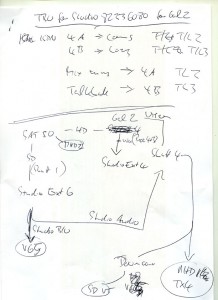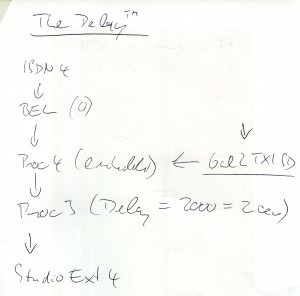
Sometimes a feed comes in, gets an English voiceover and is put straight to air on ESPN UK. But on Sunday, we pulled various aces from our sleeves to bring the Serie A “Milan Derby” to an expecting UK audience.
The feed comes in from Eutelsat W3 in HD, the studio for pre match presentation is SD, the commentators are on site in Milan and come in via ISDN. Question is: How do we synchronise comms with pictures, and how do we create HD graphics during the match?
We use pretty much EVERY piece of kit IMG Mediahouse has to offer, that’s how.
In this article, I’ll explain some of the challenges my dayjob in MCR has to offer. My colleagues and I feel like rockstars when a feat like this can successfully be pulled off, and I’m happy to say we did it once again. We’ve never done this particular route before, so it deserves a mention here.
First of all, the audio commentary will reach us instantly via 128 kbps ISDN circuit. Even though we have our man Paul Ryan on site, we have no influence on the picture circuit. It’s provided by Infront Media, who do a similar thing to the Italian Serie A football that we (IMG) do for the English Premier League: international distribution. This involves getting a feed from the stadium (either via fibre or satellite) to a dedicated facility, add graphics and potentially commentary and send it out for further satellite uplinks around the world.

Here’s the snag: By the time we see the signal, it could potentially be bounced off two satellites, each path taking roughly one second. Take into consideration compression and decompressions along the way, the pictures could arrive roughly 2-4 seconds later than the commentary reaches us – how long exactly requires a sync test. At this point, we’re not sure if the host broadcasters will let us step in front of the camera.
Even so, one delay unit alone won’t be able to provide a full 4 seconds or longer should we need it, so we’ll have to plan for TWO units. Here’s the signal path:
- ISDN commentary comes in as analogue audio
- pass through a BEL delay unit (we’ll set this to 1000ms or one second for now – maximum here is 2400ms)
- delayed output needs to be converted via Proc Amp into embedded SDI audio for distribution around the building
- Proc goes into yet another Proc with option to delay a maximum of 2600ms
- this delayed Proc is onpassed to the Studio so commentary can end up on air eventually
- in addition, an UNDELAYED version straight from the ISDN unit is passed to the Studio so the presenters can interact with the commentators in real time
That’s audio sorted. Now let’s have a look at the video signal:
- The clean pictures come in off satellite in HD
- a downconverted version is sent to the Studio
- the HD feed is sent to a HD capable gallery, which is connected via TBU to the Studio Gallery (they’re in different buildings, and we’ve run out of tie lines by this point)
- we’ll create the HD graphics in one gallery, while audio gets mixed in the main studio
- we then take this dirty HD video feed and combine it with the audio from the SD Studio via an interesting bit of kit known to us as Shuffler 4
- Shuffler 4 (HD pictures plus Studio’s audio) are sent via HD SDI to ESPN TX at Arqiva Chalfont on dedicated fibres. We’re also providing an HD ASI feed via direct line to Arqiva Newman Street, and a downconverted SD backup feed is sent via BT Tower
Confused? That’s nothing! Various requests for recordings at various stages of the process require further audio shuffling and downconversions, but let’s not mention this here.
All that counts is that all went very well and our clients were happy.
Join me next week when I’ll tell you about an interesting 32APSK downlink test we did for NFL football.
Great insight into the complexities of broadcast! You must be an adrenalin junkie?
You seem to have a great way of explaining the complexities. Do you ever do any training? I guess if you are immersed in IMG work you dont get a chance to do anything else but thought Id ask.
Great website. You seem to have got the tone just right.
Steve
I’ve never been called an “adrenaline junkie” before but I guess you’re right – at times I thrive on it. Other times I could do without it but unfortunately in live TV there’s no “pause” button (like on the Sky Plus box).
I’m getting around quite a bit: today I’m at Arqiva Winchester looking after Champions League qualifier matches and some Triathlon at the weekend. I also work for MTV at times.
When I’m not working in television, I enjoy some plastic photgraphy and hosting WordPress sites (check out wpguru.co.uk for more info). It’s an exciting life indeed!
Hello
This sounds exactly the same when i do my job far away in Bosnia.I dealt with Seria A from Italy. And sometimes can be realy hectic.One time I was waiting for TT1260 to lock on, and signal was delayed and when I called ,Italian guy explained to me on very bad english , that some mafia guys didnt alowed them to start broadcast before payment was made. That is Italy. But what I was realy soprised is matchday highlights that you put together for CUP UEFA , especialy in the begining when you have 4 feeds in same times. I was switching freqs and pol like crazy to pickup everything.Congrats.
Regards Zeljko
Hi Zeljko,
that UEFA Cup sounds like fun – from a distribution point of view at least. I think we were luckier (in that we didn’t have to work on it I guess). Glad to hear we’re not the only ones sweating when it comes to making telly 😉
Let’s bring more football to the masses, shall we?
About the Tandberg 1290 – you asked me recently if it can upconvert. The answer is YES – it has the license feature to upconvert signals. We haven’t got the option but you can get it. That way, if you set yout output to HD, the signal will always be HD even if your actual downlink is SD.
Hope this helps 😉
Jay, nice to come across your blog. Like you said, “Glad to hear we’re not the only ones sweating when it comes to making telly.” :))
I’ll come frequently to broaden my knowledge about uplinks/downlinks distribution and also video compressions.
Best regards
Budir